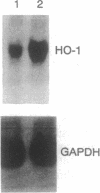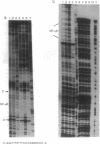Abstract
Heme oxygenase (HO) is the rate-limiting enzyme in heme catabolism and its activity is induced by many agents, including its substrate heme, heavy metals, UV radiation, and other injurious oxidant conditions. We examined the presence of several regulatory elements in the promoter region of the human HO-1 gene which could possibly account for its induction in response to diverse agents or influences. Heme treatment increased both HO activity and HO-1 mRNA in the human erythroleukemic cell line K562. Electrophoretic mobility-shift assays of nuclear protein extracts from heme-treated and control cells with specific oligonucleotide probes containing binding sites for known transcription factors, including AP-1, AP-2, Sp1, NF-kappa B, CTF/NF1, TFIID, OKT1, and CREB, and oligonucleotides containing serum-, metal-, and glucocorticoid-responsive elements demonstrated a specific and marked increase in the NF-kappa B and AP-2 transcription factors and, to a lesser extent, an increase in AP-1. No significant increase in other transcription factors over the control, untreated cells was observed. DNase I footprint assays using purified transcription factors revealed the presence of NF-kappa B and AP-2 binding sites in the proximal part of the promoter region of the human HO-1 gene. Moreover, nucleotide sequence analysis of the HO-1 promoter region showed that the protected regions encompassed NF-kappa B and AP-2 consensus binding sites. The presence of regulatory sequences for the binding of transcription factors such as NF-kappa B and AP-2, whose activation is associated with the immediate response of the cell to an injury, may be an indication of the important role which HO-1 may play in defense mechanisms against tissue injury.
Full text
PDF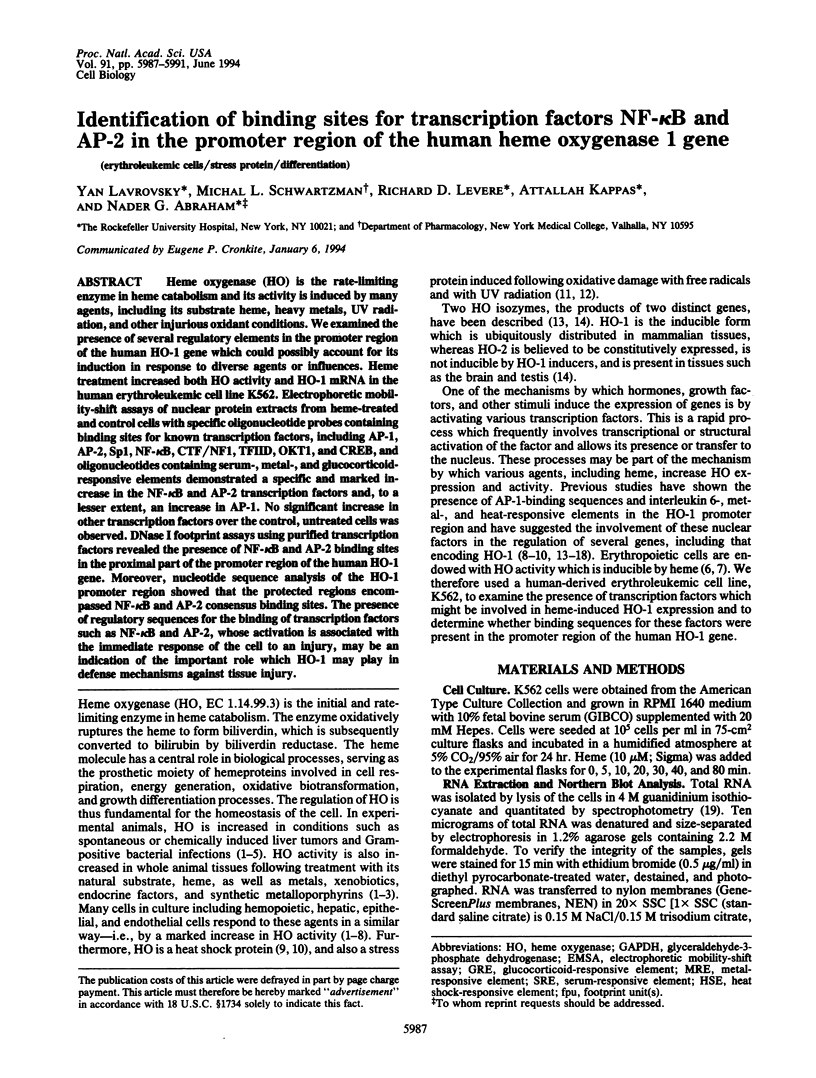
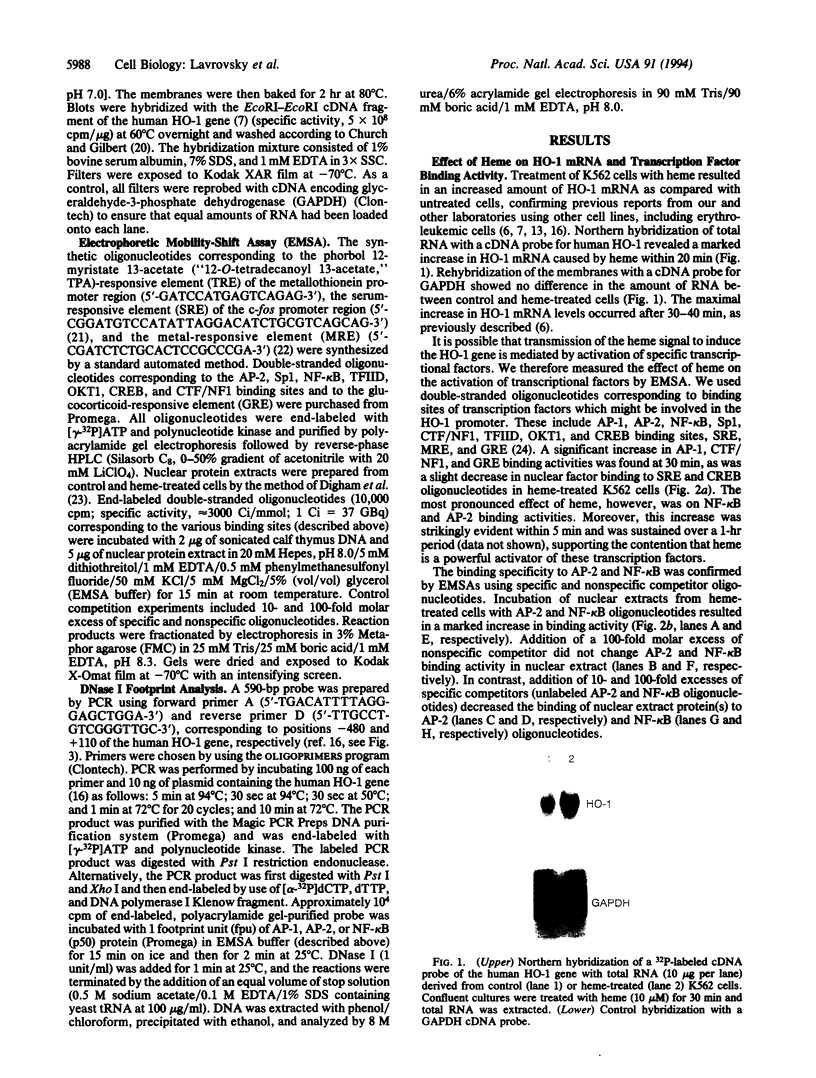
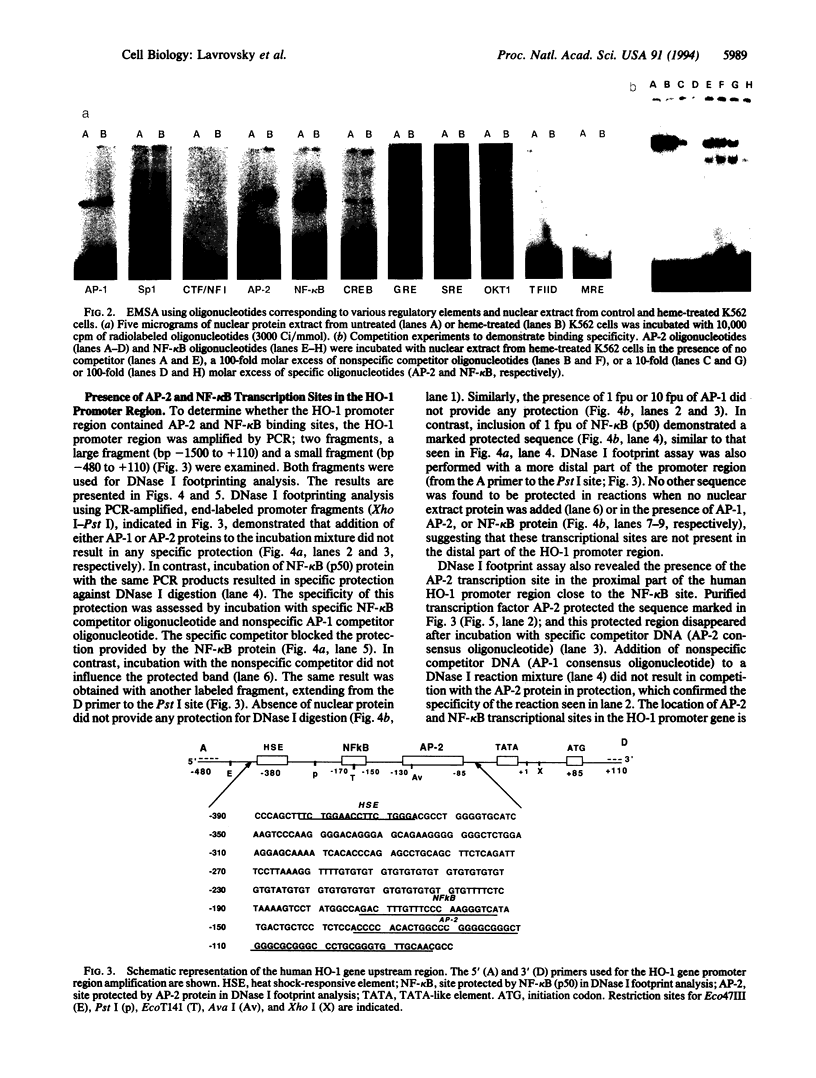
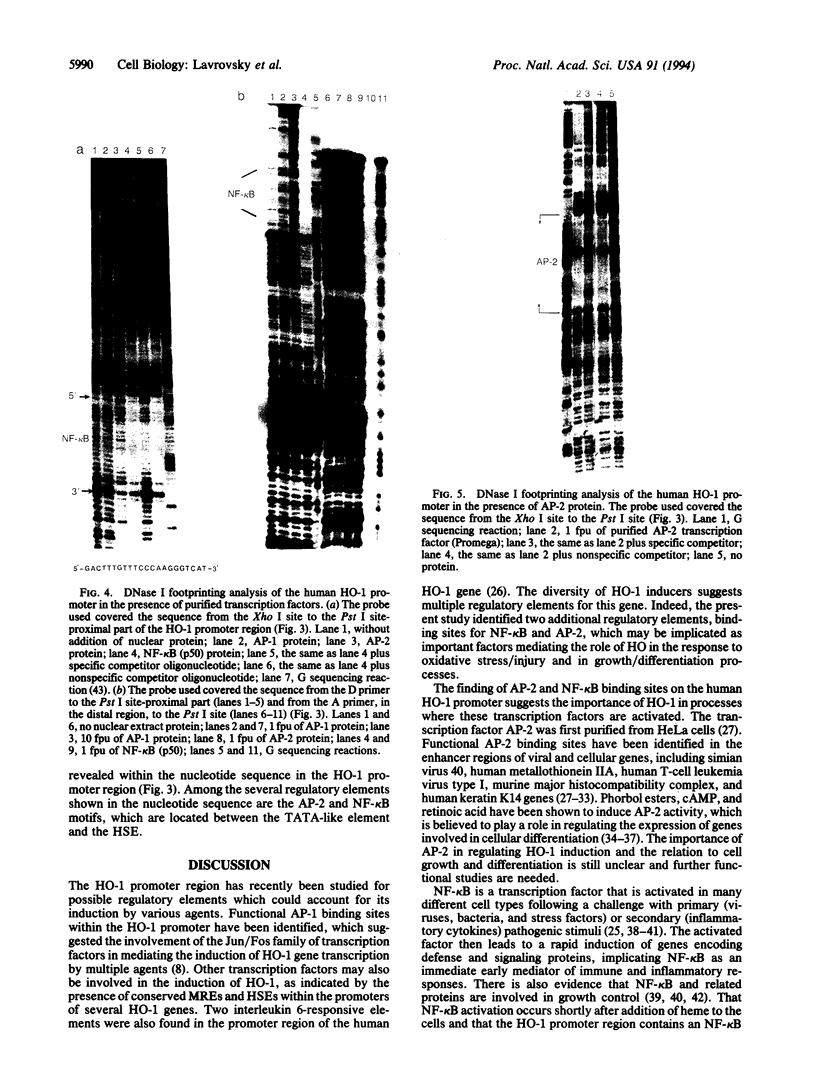
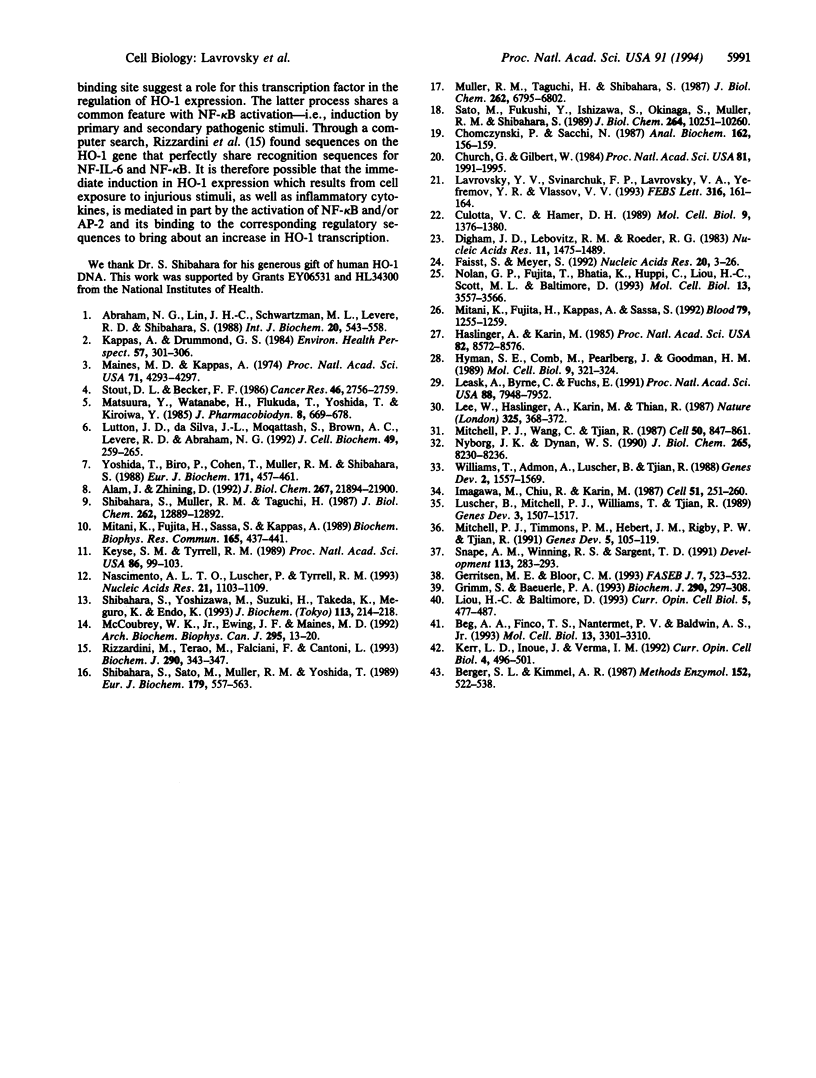
Images in this article
Selected References
These references are in PubMed. This may not be the complete list of references from this article.
- Abraham N. G., Lin J. H., Schwartzman M. L., Levere R. D., Shibahara S. The physiological significance of heme oxygenase. Int J Biochem. 1988;20(6):543–558. doi: 10.1016/0020-711x(88)90093-6. [DOI] [PubMed] [Google Scholar]
- Alam J., Den Z. Distal AP-1 binding sites mediate basal level enhancement and TPA induction of the mouse heme oxygenase-1 gene. J Biol Chem. 1992 Oct 25;267(30):21894–21900. [PubMed] [Google Scholar]
- Ambrose B. J., Pless R. C. DNA sequencing: chemical methods. Methods Enzymol. 1987;152:522–538. doi: 10.1016/0076-6879(87)52059-6. [DOI] [PubMed] [Google Scholar]
- Beg A. A., Finco T. S., Nantermet P. V., Baldwin A. S., Jr Tumor necrosis factor and interleukin-1 lead to phosphorylation and loss of I kappa B alpha: a mechanism for NF-kappa B activation. Mol Cell Biol. 1993 Jun;13(6):3301–3310. doi: 10.1128/mcb.13.6.3301. [DOI] [PMC free article] [PubMed] [Google Scholar]
- Chomczynski P., Sacchi N. Single-step method of RNA isolation by acid guanidinium thiocyanate-phenol-chloroform extraction. Anal Biochem. 1987 Apr;162(1):156–159. doi: 10.1006/abio.1987.9999. [DOI] [PubMed] [Google Scholar]
- Church G. M., Gilbert W. Genomic sequencing. Proc Natl Acad Sci U S A. 1984 Apr;81(7):1991–1995. doi: 10.1073/pnas.81.7.1991. [DOI] [PMC free article] [PubMed] [Google Scholar]
- Culotta V. C., Hamer D. H. Fine mapping of a mouse metallothionein gene metal response element. Mol Cell Biol. 1989 Mar;9(3):1376–1380. doi: 10.1128/mcb.9.3.1376. [DOI] [PMC free article] [PubMed] [Google Scholar]
- Dignam J. D., Lebovitz R. M., Roeder R. G. Accurate transcription initiation by RNA polymerase II in a soluble extract from isolated mammalian nuclei. Nucleic Acids Res. 1983 Mar 11;11(5):1475–1489. doi: 10.1093/nar/11.5.1475. [DOI] [PMC free article] [PubMed] [Google Scholar]
- Faisst S., Meyer S. Compilation of vertebrate-encoded transcription factors. Nucleic Acids Res. 1992 Jan 11;20(1):3–26. doi: 10.1093/nar/20.1.3. [DOI] [PMC free article] [PubMed] [Google Scholar]
- Gerritsen M. E., Bloor C. M. Endothelial cell gene expression in response to injury. FASEB J. 1993 Apr 1;7(6):523–532. doi: 10.1096/fasebj.7.6.8472891. [DOI] [PubMed] [Google Scholar]
- Grimm S., Baeuerle P. A. The inducible transcription factor NF-kappa B: structure-function relationship of its protein subunits. Biochem J. 1993 Mar 1;290(Pt 2):297–308. doi: 10.1042/bj2900297. [DOI] [PMC free article] [PubMed] [Google Scholar]
- Haslinger A., Karin M. Upstream promoter element of the human metallothionein-IIA gene can act like an enhancer element. Proc Natl Acad Sci U S A. 1985 Dec;82(24):8572–8576. doi: 10.1073/pnas.82.24.8572. [DOI] [PMC free article] [PubMed] [Google Scholar]
- Hyman S. E., Comb M., Pearlberg J., Goodman H. M. An AP-2 element acts synergistically with the cyclic AMP- and phorbol ester-inducible enhancer of the human proenkephalin gene. Mol Cell Biol. 1989 Jan;9(1):321–324. doi: 10.1128/mcb.9.1.321. [DOI] [PMC free article] [PubMed] [Google Scholar]
- Imagawa M., Chiu R., Karin M. Transcription factor AP-2 mediates induction by two different signal-transduction pathways: protein kinase C and cAMP. Cell. 1987 Oct 23;51(2):251–260. doi: 10.1016/0092-8674(87)90152-8. [DOI] [PubMed] [Google Scholar]
- Kappas A., Drummond G. S. Control of heme and cytochrome P-450 metabolism by inorganic metals, organometals and synthetic metalloporphyrins. Environ Health Perspect. 1984 Aug;57:301–306. doi: 10.1289/ehp.8457301. [DOI] [PMC free article] [PubMed] [Google Scholar]
- Kerr L. D., Inoue J., Verma I. M. Signal transduction: the nuclear target. Curr Opin Cell Biol. 1992 Jun;4(3):496–501. doi: 10.1016/0955-0674(92)90017-7. [DOI] [PubMed] [Google Scholar]
- Keyse S. M., Tyrrell R. M. Heme oxygenase is the major 32-kDa stress protein induced in human skin fibroblasts by UVA radiation, hydrogen peroxide, and sodium arsenite. Proc Natl Acad Sci U S A. 1989 Jan;86(1):99–103. doi: 10.1073/pnas.86.1.99. [DOI] [PMC free article] [PubMed] [Google Scholar]
- Lavrovsky Y. V., Svinarchuk F. P., Lavrovsky V. A., Yefremov Y. R., Vlassov V. V. c-fos gene expression in cell revertants from a transformed to a pseudonormal phenotype. FEBS Lett. 1993 Jan 25;316(2):161–164. doi: 10.1016/0014-5793(93)81207-g. [DOI] [PubMed] [Google Scholar]
- Leask A., Byrne C., Fuchs E. Transcription factor AP2 and its role in epidermal-specific gene expression. Proc Natl Acad Sci U S A. 1991 Sep 15;88(18):7948–7952. doi: 10.1073/pnas.88.18.7948. [DOI] [PMC free article] [PubMed] [Google Scholar]
- Lee W., Haslinger A., Karin M., Tjian R. Activation of transcription by two factors that bind promoter and enhancer sequences of the human metallothionein gene and SV40. Nature. 1987 Jan 22;325(6102):368–372. doi: 10.1038/325368a0. [DOI] [PubMed] [Google Scholar]
- Liou H. C., Baltimore D. Regulation of the NF-kappa B/rel transcription factor and I kappa B inhibitor system. Curr Opin Cell Biol. 1993 Jun;5(3):477–487. doi: 10.1016/0955-0674(93)90014-h. [DOI] [PubMed] [Google Scholar]
- Lutton J. D., da Silva J. L., Moqattash S., Brown A. C., Levere R. D., Abraham N. G. Differential induction of heme oxygenase in the hepatocarcinoma cell line (Hep3B) by environmental agents. J Cell Biochem. 1992 Jul;49(3):259–265. doi: 10.1002/jcb.240490308. [DOI] [PubMed] [Google Scholar]
- Lüscher B., Mitchell P. J., Williams T., Tjian R. Regulation of transcription factor AP-2 by the morphogen retinoic acid and by second messengers. Genes Dev. 1989 Oct;3(10):1507–1517. doi: 10.1101/gad.3.10.1507. [DOI] [PubMed] [Google Scholar]
- Maines M. D., Kappas A. Cobalt induction of hepatic heme oxygenase; with evidence that cytochrome P-450 is not essential for this enzyme activity. Proc Natl Acad Sci U S A. 1974 Nov;71(11):4293–4297. doi: 10.1073/pnas.71.11.4293. [DOI] [PMC free article] [PubMed] [Google Scholar]
- Matsuura Y., Watanabe H., Fukuda T., Yoshida T., Kuroiwa Y. A sustained increase of microsomal heme oxygenase activity following treatment of rats with Bacillus Calmette-Guerin and Corynebacterium parvum: its possible relation to the decrease of cytochrome P-450 content. J Pharmacobiodyn. 1985 Aug;8(8):669–678. doi: 10.1248/bpb1978.8.669. [DOI] [PubMed] [Google Scholar]
- McCoubrey W. K., Jr, Ewing J. F., Maines M. D. Human heme oxygenase-2: characterization and expression of a full-length cDNA and evidence suggesting that the two HO-2 transcripts may differ by choice of polyadenylation signal. Arch Biochem Biophys. 1992 May 15;295(1):13–20. doi: 10.1016/0003-9861(92)90481-b. [DOI] [PubMed] [Google Scholar]
- Mitani K., Fujita H., Kappas A., Sassa S. Heme oxygenase is a positive acute-phase reactant in human Hep3B hepatoma cells. Blood. 1992 Mar 1;79(5):1255–1259. [PubMed] [Google Scholar]
- Mitani K., Fujita H., Sassa S., Kappas A. Heat shock induction of heme oxygenase mRNA in human Hep 3B hepatoma cells. Biochem Biophys Res Commun. 1989 Nov 30;165(1):437–441. doi: 10.1016/0006-291x(89)91089-9. [DOI] [PubMed] [Google Scholar]
- Mitchell P. J., Timmons P. M., Hébert J. M., Rigby P. W., Tjian R. Transcription factor AP-2 is expressed in neural crest cell lineages during mouse embryogenesis. Genes Dev. 1991 Jan;5(1):105–119. doi: 10.1101/gad.5.1.105. [DOI] [PubMed] [Google Scholar]
- Mitchell P. J., Wang C., Tjian R. Positive and negative regulation of transcription in vitro: enhancer-binding protein AP-2 is inhibited by SV40 T antigen. Cell. 1987 Sep 11;50(6):847–861. doi: 10.1016/0092-8674(87)90512-5. [DOI] [PubMed] [Google Scholar]
- Müller R. M., Taguchi H., Shibahara S. Nucleotide sequence and organization of the rat heme oxygenase gene. J Biol Chem. 1987 May 15;262(14):6795–6802. [PubMed] [Google Scholar]
- Nascimento A. L., Luscher P., Tyrrell R. M. Ultraviolet A (320-380 nm) radiation causes an alteration in the binding of a specific protein/protein complex to a short region of the promoter of the human heme oxygenase 1 gene. Nucleic Acids Res. 1993 Mar 11;21(5):1103–1109. doi: 10.1093/nar/21.5.1103. [DOI] [PMC free article] [PubMed] [Google Scholar]
- Nolan G. P., Fujita T., Bhatia K., Huppi C., Liou H. C., Scott M. L., Baltimore D. The bcl-3 proto-oncogene encodes a nuclear I kappa B-like molecule that preferentially interacts with NF-kappa B p50 and p52 in a phosphorylation-dependent manner. Mol Cell Biol. 1993 Jun;13(6):3557–3566. doi: 10.1128/mcb.13.6.3557. [DOI] [PMC free article] [PubMed] [Google Scholar]
- Nyborg J. K., Dynan W. S. Interaction of cellular proteins with the human T-cell leukemia virus type I transcriptional control region. Purification of cellular proteins that bind the 21-base pair repeat elements. J Biol Chem. 1990 May 15;265(14):8230–8236. [PubMed] [Google Scholar]
- Rizzardini M., Terao M., Falciani F., Cantoni L. Cytokine induction of haem oxygenase mRNA in mouse liver. Interleukin 1 transcriptionally activates the haem oxygenase gene. Biochem J. 1993 Mar 1;290(Pt 2):343–347. doi: 10.1042/bj2900343. [DOI] [PMC free article] [PubMed] [Google Scholar]
- Sato M., Fukushi Y., Ishizawa S., Okinaga S., Müller R. M., Shibahara S. Transcriptional control of the rat heme oxygenase gene by a nuclear protein that interacts with adenovirus 2 major late promoter. J Biol Chem. 1989 Jun 15;264(17):10251–10260. [PubMed] [Google Scholar]
- Shibahara S., Müller R. M., Taguchi H. Transcriptional control of rat heme oxygenase by heat shock. J Biol Chem. 1987 Sep 25;262(27):12889–12892. [PubMed] [Google Scholar]
- Shibahara S., Sato M., Muller R. M., Yoshida T. Structural organization of the human heme oxygenase gene and the function of its promoter. Eur J Biochem. 1989 Feb 15;179(3):557–563. doi: 10.1111/j.1432-1033.1989.tb14583.x. [DOI] [PubMed] [Google Scholar]
- Shibahara S., Yoshizawa M., Suzuki H., Takeda K., Meguro K., Endo K. Functional analysis of cDNAs for two types of human heme oxygenase and evidence for their separate regulation. J Biochem. 1993 Feb;113(2):214–218. doi: 10.1093/oxfordjournals.jbchem.a124028. [DOI] [PubMed] [Google Scholar]
- Snape A. M., Winning R. S., Sargent T. D. Transcription factor AP-2 is tissue-specific in Xenopus and is closely related or identical to keratin transcription factor 1 (KTF-1). Development. 1991 Sep;113(1):283–293. doi: 10.1242/dev.113.1.283. [DOI] [PubMed] [Google Scholar]
- Stout D. L., Becker F. F. Heme enzyme patterns in genetically and chemically induced mouse liver tumors. Cancer Res. 1986 Jun;46(6):2756–2759. [PubMed] [Google Scholar]
- Williams T., Admon A., Lüscher B., Tjian R. Cloning and expression of AP-2, a cell-type-specific transcription factor that activates inducible enhancer elements. Genes Dev. 1988 Dec;2(12A):1557–1569. doi: 10.1101/gad.2.12a.1557. [DOI] [PubMed] [Google Scholar]
- Yoshida T., Biro P., Cohen T., Müller R. M., Shibahara S. Human heme oxygenase cDNA and induction of its mRNA by hemin. Eur J Biochem. 1988 Feb 1;171(3):457–461. doi: 10.1111/j.1432-1033.1988.tb13811.x. [DOI] [PubMed] [Google Scholar]



